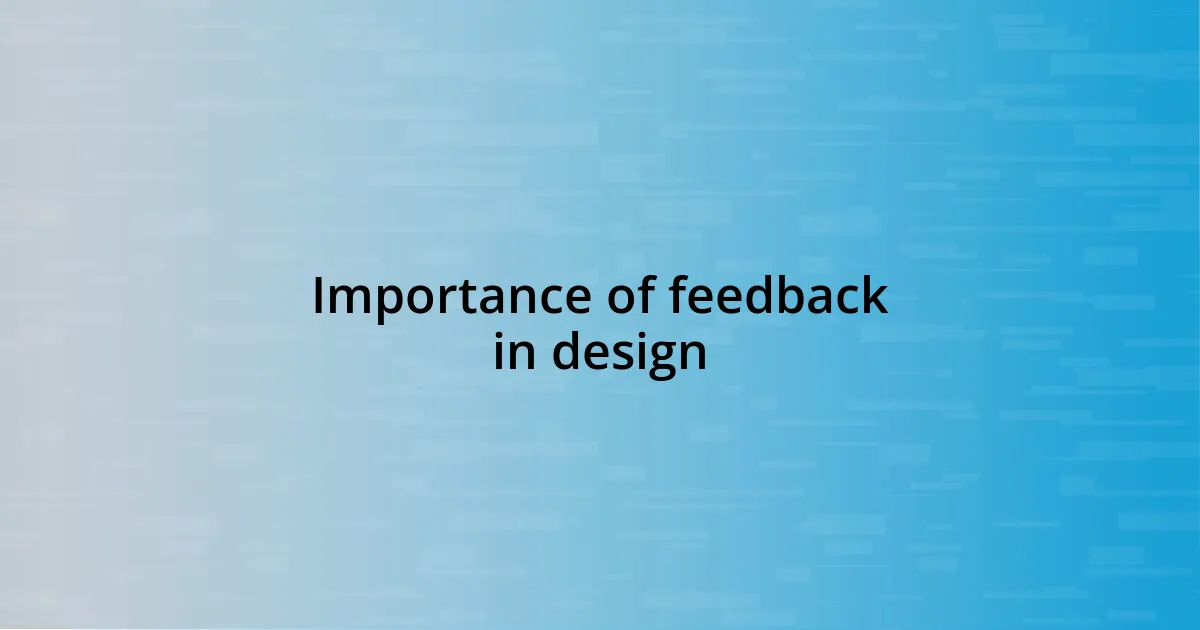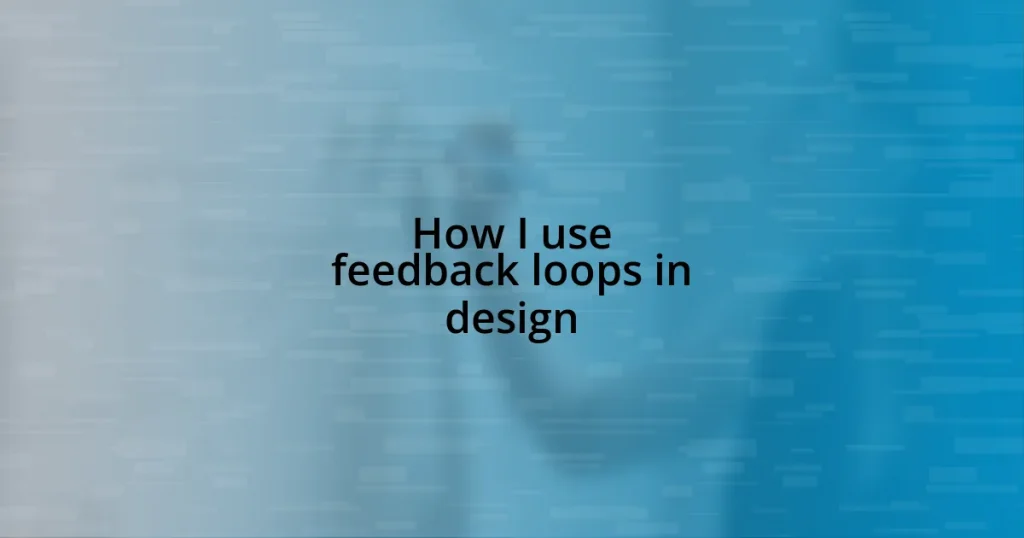Key takeaways:
- Feedback loops are essential for refining user experience, allowing designers to adapt their vision to align with user needs.
- Different types of feedback—informal conversations, surveys, usability testing, and analytics—offer unique insights that enhance the design process.
- Effective feedback collection requires clear objectives and open communication to foster collaboration and meaningful improvements.
- Analyzing feedback for patterns can reveal significant usability issues, driving design changes that resonate with users’ emotional experiences.

Understanding feedback loops in design
Feedback loops in design are crucial for refining and optimizing the user experience. I always remember a project where I thought my design was perfect, only to realize, after gathering user feedback, that it fell short of their expectations. Isn’t it interesting how we can be so immersed in our own vision that we sometimes miss the mark on user needs?
When I incorporate feedback loops, I often find that the smallest tweaks can lead to substantial improvements. For instance, a simple change based on user comments transformed a clunky interface into a seamless experience. Have you ever noticed how a minor adjustment, influenced by real users, can shift the entire design’s effectiveness?
Perhaps the most gratifying part of feedback loops is witnessing the evolution of a design over time. Each iteration, shaped by user insights, creates a sense of community and shared ownership in the project. It’s like collaborating with my users; they become part of the process. How have you engaged with your audience through feedback? I believe it can truly make a difference in the outcome.

Importance of feedback in design
Feedback is vital in design because it bridges the gap between the creator’s vision and the user’s reality. I recall a project where feedback came in the form of usability testing; a user’s struggle with a feature I thought was intuitive highlighted just how critical it is to involve end-users. Their perspective was eye-opening—it reminded me that assumptions can often lead to pitfalls.
Moreover, feedback creates an opportunity for learning and growth. I once received a comment on a design element I had a particular fondness for. Initially defensive, I later realized that it was their perspective that encouraged me to explore alternatives I hadn’t considered, resulting in an outcome far better than I could have achieved alone. How often do we miss the chance to grow because we cling too tightly to our ideas?
Ultimately, the feedback I receive is a gift that helps shape my designs to be more user-centric. It’s refreshing to know that with every input, my designs evolve and not only serve the intended purpose but also resonate on a deeper emotional level with users. Isn’t it rewarding to see how our creations can be refined into something truly valuable for others?
| Feedback Importance | Impact on Design |
|---|---|
| User Insights | Enhances usability and relevance |
| Iterative Improvement | Leads to refined and optimized solutions |

Types of feedback loops
Feedback loops can take various forms, each offering unique advantages to the design process. I’ve found that informal feedback, such as quick conversations with coworkers, often yields immediate insights. In contrast, structured feedback, like surveys or usability tests, provides in-depth data that you can sink your teeth into. Each type of loop has its place in the design journey, and knowing when to use which can really enhance your project’s outcome.
Here’s a brief breakdown of the types of feedback loops I commonly utilize:
- Informal Feedback: Quick chats or casual observations from peers often reveal overlooked issues.
- Surveys: Gathering user opinions through structured questions helps quantify feedback and identify trends.
- Usability Testing: Direct observations of users interacting with my design shed light on pain points and encourage actionable improvements.
- Analytics: Data from user interactions guides design decisions based on real-world usage.
I’ve had experiences where combining these loops led to surprising revelations. For example, when I relied solely on analytics to make design decisions, I missed the emotional aspect of user experience. After integrating qualitative feedback from interviews, I discovered how users felt about the design rather than just how they interacted with it. Embracing a variety of feedback loops truly empowers the design process and helps craft experiences that resonate on multiple levels.

Creating effective feedback loops
Creating effective feedback loops requires careful consideration of the dynamics between the designer and the user. In my experience, fostering a culture of open communication makes a world of difference. For instance, during a recent project, I encouraged team members to share their thoughts freely. This openness not only made everyone feel valued but also led to surprising insights that significantly enhanced the final product. Have you ever felt that a single conversation could change your perspective entirely?
I also learned early on how essential it is to set clear objectives when gathering feedback. Without a focused goal, the feedback can become overwhelming and less actionable. In one instance, I gathered feedback on multiple features but didn’t specify what I wanted to learn. This resulted in a disorganized collection of comments that didn’t lead to meaningful improvements. Narrowing down the scope allowed me to tackle specific issues and see clearer paths for enhancement.
Lastly, timing plays a critical role in the effectiveness of feedback loops. I’ve found that seeking input early and often enables iterative refinements that can transform a fair design into something outstanding. There was a particular project where I shared initial sketches with users, and their input allowed me to pivot in a way that truly addressed their needs before I even created a prototype. Doesn’t it feel empowering to adapt your designs based on real-time responses instead of waiting until the end?

Implementing feedback during design process
Implementing feedback during the design process is not just about collecting opinions; it’s about weaving insights into the fabric of the design itself. I remember a project where we had some rough draft concepts ready. After an initial round of feedback, a colleague pointed out a feature that seemed clear to us but confused users. That simple observation reshaped our approach and led to a more intuitive design solution. Have you ever realized that a slight tweak based on feedback can make all the difference?
Incorporating user feedback at different stages can significantly enhance the design outcome. During one project, after receiving feedback from usability tests, I chose to adjust not only the visual elements but also the flow of the user journey. Witnessing users struggle with a design aspect gave me insight into their emotional disconnect, prompting me to rethink the entire interaction. This iterative process transformed my work and deepened my understanding of user-centric design.
It’s also vital to embrace feedback as a collaborative effort, rather than something to dread. I often approach feedback sessions with a mindset of curiosity, which opens the door to unexpected discoveries. For instance, during a brainstorming session, a quiet team member shared an entirely new perspective. Their fresh idea sparked a lively discussion that completely altered our design trajectory. Have you ever experienced that moment when someone else’s input ignites creativity in ways you couldn’t have imagined alone?

Analyzing feedback for improvements
Analyzing feedback involves sifting through the nuggets of insight to identify areas for improvement. I recall a time when I overlooked critical user comments during the review phase, thinking they were too specific. When I finally revisited those notes with an open mind, I discovered vital themes that pointed to usability issues I’d previously missed. It’s fascinating how seemingly small details can have a significant impact on the overall user experience, don’t you think?
When I analyze feedback, I always look for patterns. There was a project where users kept mentioning a particular navigation element as confusing. At first, I thought it was just a few outliers chiming in. However, upon closer examination, it was evident that multiple users were struggling with the same aspect. This realization highlighted a crucial area for redesign, emphasizing how collective insights can reveal larger issues in a design. It’s like finding a piece of a puzzle that suddenly makes the whole picture clearer.
Delving deep into feedback often leads to unexpected revelations. I vividly remember reviewing session recordings where users hesitated or fumbled through interactions. Observing their reactions—sometimes frustration or confusion—instantly drove home the point that empathy is essential in design. These moments, rich with emotional nuance, remind me that behind every piece of feedback is a real person with real needs, turning data into stories that guide our design decisions.














